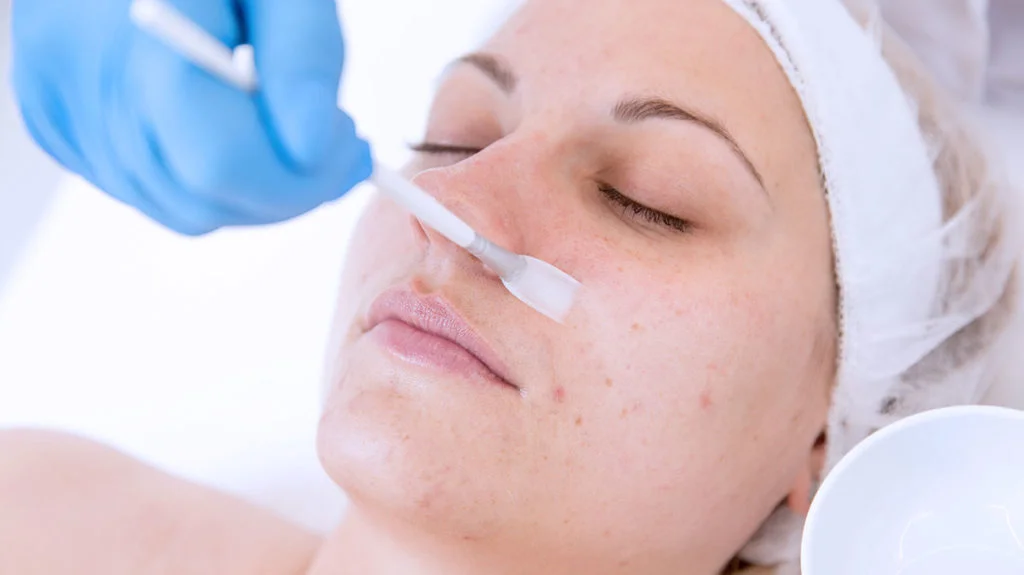A chemical peel is a powerful skincare treatment designed to exfoliate the skin, remove dead skin cells, and promote the growth of new, healthy skin. This non-invasive procedure has gained immense popularity for its ability to reduce acne scars, wrinkles, fine lines, and hyperpigmentation, revealing a smoother, clearer, and more youthful complexion.
By using a carefully formulated chemical solution, a chemical peel accelerates cell turnover, unclogs pores, and stimulates collagen production, making it one of the most effective treatments for various skin concerns. Whether you’re dealing with stubborn acne scars, sun damage, or early signs of aging, a chemical peel can significantly improve your skin’s texture and appearance.
This guide explores everything you need to know about chemical peels, including types, benefits, how they work, what to expect during and after the treatment, and expert skincare tips for optimal results.
What is a Chemical Peel?
A chemical peel is a cosmetic treatment that involves applying a chemical solution to the skin to exfoliate and remove damaged outer layers. This process helps to:
- Unclog pores and treat acne
- Fade acne scars and hyperpigmentation
- Reduce fine lines and wrinkles
- Improve skin texture and tone
- Stimulate collagen production for firmer skin
Chemical peels can range from mild to deep, depending on the strength of the solution used and the depth of skin penetration required for treatment.
How Does a Chemical Peel Work?
Chemical peels work by breaking down the bonds between dead skin cells, allowing the outermost layers to peel off. This reveals fresh, new skin that is smoother, more even-toned, and free of blemishes.
Step-by-Step Process of a Chemical Peel Treatment
- Cleansing: The skin is cleansed to remove dirt, oil, and makeup.
- Application: A chemical solution (such as glycolic acid, salicylic acid, or trichloroacetic acid) is applied to the skin.
- Reaction: The solution penetrates the skin and begins to dissolve dead skin cells and impurities.
- Neutralization: If necessary, a neutralizing agent is applied to stop the chemical reaction.
- Peeling Process: Over the next few days, the outer skin layers begin to peel away, revealing fresh, youthful skin.
Types of Chemical Peels
1. Superficial Peels (Light Peels)
- Use mild acids like alpha-hydroxy acid (AHA) or beta-hydroxy acid (BHA).
- Gently exfoliate the skin without significant peeling.
- Ideal for minor skin imperfections, dullness, and acne-prone skin.
- Downtime: Minimal, with slight redness that fades quickly.
2. Medium Peels
- Use stronger acids like trichloroacetic acid (TCA) or glycolic acid.
- Penetrates deeper into the skin to treat moderate wrinkles, acne scars, and pigmentation.
- Results in noticeable peeling over several days.
- Downtime: 5-7 days of recovery, with some redness and flaking.
3. Deep Peels
- Use phenol or high-strength TCA for severe skin damage, deep wrinkles, and scars.
- Requires longer recovery time and is often performed under medical supervision.
- Results last for years, making it one of the most effective peels.
- Downtime: 2-3 weeks, with significant peeling and redness.
Benefits of Chemical Peels for Skin Transformation
1. Acne Treatment & Scar Reduction
- Removes excess oil and unclogs pores, reducing breakouts.
- Diminishes acne scars by promoting skin cell regeneration.
- Kills acne-causing bacteria, preventing future breakouts.
2. Wrinkle & Fine Line Reduction
- Stimulates collagen and elastin production, improving skin elasticity.
- Smooths out wrinkles, crow’s feet, and fine lines.
- Encourages firmer, more youthful-looking skin.
3. Hyperpigmentation & Dark Spot Removal
- Fades melasma, sunspots, and post-inflammatory hyperpigmentation.
- Creates a more even skin tone.
4. Improved Skin Texture & Radiance
- Removes dull, damaged skin layers for a brighter complexion.
- Reduces rough texture, dryness, and enlarged pores.
5. Boosts Skincare Product Effectiveness
- Allows serums and moisturizers to penetrate deeper, enhancing their effectiveness.
Who is a Good Candidate for a Chemical Peel?
A chemical peel is suitable for most skin types and is recommended for individuals who want to:
✔ Improve acne-prone or oily skin
✔ Reduce wrinkles, fine lines, and early signs of aging
✔ Lighten hyperpigmentation, sunspots, and dark spots
✔ Improve skin texture and overall radiance
However, pregnant women, individuals with sensitive skin, and those with active infections should consult a dermatologist before undergoing a chemical peel.
What to Expect After a Chemical Peel?
After a chemical peel, you may experience:
- Mild redness and sensitivity (similar to a sunburn).
- Peeling and flaking (depending on the peel depth).
- Tighter and smoother skin within a few days.
- Visible improvements in acne scars, wrinkles, and pigmentation after multiple sessions.
Post-Care Tips for the Best Results
- Avoid sun exposure for at least a week and apply SPF 30+ sunscreen daily.
- Do not pick or peel the skin to prevent scarring.
- Stay hydrated and moisturize to keep the skin healthy.
- Avoid harsh skincare products like retinoids and exfoliants for a few days.
Chemical Peel vs. Other Skin Treatments
| Treatment | Best For | Downtime | Results |
|---|---|---|---|
| Chemical Peel | Acne, wrinkles, pigmentation | Varies (light peels: none, deep peels: 2-3 weeks) | 1-4 weeks |
| Laser Resurfacing | Deep wrinkles, scars | 1-2 weeks | 2-6 months |
| Microdermabrasion | Mild exfoliation, dull skin | None | Immediate |
| Microneedling | Collagen stimulation, scars | 1-3 days | 3-6 months |
How Often Should You Get a Chemical Peel?
- Light Peel: Every 4-6 weeks for maintenance.
- Medium Peel: Every 3-6 months for deeper correction.
- Deep Peel: Once every 1-2 years due to long-lasting effects.
Conclusion: Is a Chemical Peel Right for You?
A chemical peel is one of the most effective skin rejuvenation treatments available, offering acne reduction, wrinkle smoothing, scar fading, and overall skin renewal. Whether you’re looking for a quick glow-up or long-term skin transformation, chemical peels can be customized to suit your skin type and concerns.
By following proper aftercare and maintenance, you can enjoy smoother, healthier, and younger-looking skin for years to come.
Email : info@sasaestheticaclinicuae.com
Phone Number : +971 50 394 3308
Website : sasaestheticaclinicuae.com
WhatsApp : +971 50 394 3308

